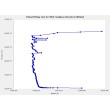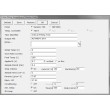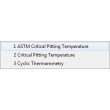The Critical Pitting Temperature Software controls a Gamry Potentiostat, TDC5 Temperature Controller, and associated accessories to automatically measure the Critical Pitting Temperature of a material. Applications for the Critical Pitting Temperature Software include materials selection in the chemical process industry, study of bio-implants, alloy ranking, or evaluating pitting inhibitors.
Software
Product Details
Overview
The CPT Software runs the Critical Pitting Temperature experiment that is described in ASTM G 150 (Standard Test Method for Electrochemical Critical Pitting Temperature Testing of Stainless Steels), as well as Cyclic Thermammetry. Applications for this software include materials selection in the chemical process industry, alloy ranking, or evaluating pitting inhibitors. Anywhere you have a pitting problem, the Critical Pitting Temperature Software techniques, coupled with cyclic polarization or critical pitting potential scans, will be useful.
Features
- Temperature Control
- The TDC5 Temperature Controller is required in order to control the cell temperature. It connects to the computer via RS-232 Serial Port or USB port and can control the cell temperature to reach the 1° C/minute rate that is desired for CPT testing. The TDC5's two switchable outlets are under software control and can also be used for controlling pumps, stirrers, rotators, etc. For heating, we recommend a Heating Mantle (Part No. 990-147,148).
- Electrochemical Cells
- Gamry's Flexcell is designed to counteract a problem that plagues most other flat sample designs -- crevice corrosion around the specimen seal. First popularized by Avesta Steel, the cell utilizes a flooded gasket seal design to eliminate crevice corrosion between the sample and its holder. This simple yet elegant design results in an easy to use, reliable, crevice free system.
- The MultiPort Corrosion Cell can also be used for the determination of Critical Pitting Temperature. The MultiPort is designed for "non-flat" samples such as rods, bars, or billets. Cooling can be accomplished in the MultiPort with a Teflon-Coated Copper Coil (Part No. 935-45).
System Requirements
- Gamry PCI4/Series G, Reference, or Interface Family Instrument
- Microsoft® Windows™ XP SP3/Vista/7/8/10/11 (32-bit or 64-bit)
Experiments
Critical Pitting Temperature
Temperature is increased in steps while the current is monitored at a fixed potential. The temperature is controlled within 1º C during the experiment. The resulting data is a series of current/time curves at different temperatures, allowing you to determine the critical pitting breakdown temperature of your system.
Cyclic Thermammetry
The cell temperature is slowly ramped up while cell current is measured. A constant anodic potential is applied. When either the temperature or current hit a predetermined limit the scan is reversed. The result is a curve very similar to a cyclic pitting scan, but with temperature as the independent variable.
CPT Testing of Stainless Steels (ASTM G150)
The ASTM G150 test provides a prediction of resistance to pitting propagation on stainless steels. Similar to Cyclic Thermammetry described above, G150 ramps the temperature at 1° C/minute while applying a constant anodic potential. Current is monitored during the temperature scan until a rapid increase is recorded. The CPT point is defined at the time a rapid current increase occurs, or when current density exceeds 100 µA/cm2.






